Metatarsalgia may sound like a rare dinosaur, but it’s actually a common overuse injury that strikes right where your toes meet the rest of your foot—also known as the “ball of fire” when it flares up. That sharp, burning pain and inflammation in the forefoot can turn every step into a wince-worthy adventure, especially if you’re running or walking a lot.
The main troublemaker? Activities that put too much pressure on the front of your foot. But structural quirks in your bones, muscle imbalances, or existing foot conditions can also pile on the misery. It sneaks up on you gradually, like a bad habit—but just to keep things spicy, it often gets confused with Morton’s neuroma, which throws a similar pain party in the same neighborhood.
Luckily, both conditions benefit from one magical solution: the right shoes. The best shoes for metatarsalgia offer plush cushioning, solid support, and enough forefoot room to keep your toes from staging a revolt. And yes, replacing those worn-out kicks regularly isn’t optional—it’s foot survival 101.
Disclaimer! This blog post is for those dealing with mild, manageable metatarsalgia—the kind that’s more “annoying twinge” than “call an ambulance.” It’s especially geared toward our fellow older runners who’ve started making more noise getting off the couch than during their 10Ks. We’re not doctors (we don’t even play one on TV), so please don’t treat this as medical advice. If your metatarsal bones are staging a full rebellion, it’s best to chat with a real professional.
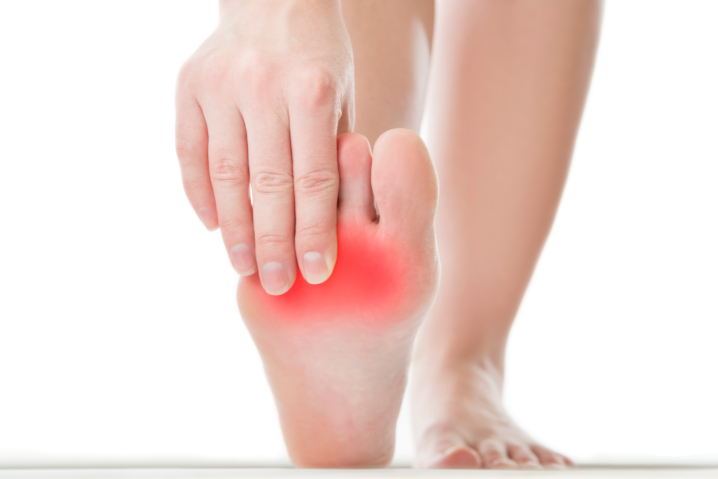
Importance of Proper Footwear
Role of Shoes in Alleviating Pain
Shoes aren’t just a fashion statement—they’re your first line of defense against the fiery wrath of metatarsalgia. The right pair can turn your daily walk from “ouch” to “ahh” by offering proper support, plush cushioning, and foot-friendly alignment. Think of them as tiny orthopedic therapists for your feet. When shopping for relief (and style), look for features like:
- Arch Support: Shoes with good arch support are like a well-balanced friend group—they spread the pressure evenly so your poor metatarsal bones don’t take all the heat (literally).
- Cushioning: Plush cushioning in the forefoot is like a pillow-top mattress for your toes—it soaks up shock, softens every step, and keeps your feet from throwing a tantrum every time you walk or stand.
- Roomy Toe Box: A wider toe box gives your toes the freedom to spread out like they’re on vacation—no cramped quarters, no pressure drama, and definitely no angry metatarsal meltdowns.
- Heel Height: Low to moderate heel heights help your feet stay in their natural, drama-free position—because the only thing high heels elevate is forefoot misery. Keep it low, keep it comfy, and your feet will thank you by not plotting revenge.
- Stability Features: Shoes with stability features are like foot babysitters—they keep everything aligned, in check, and out of trouble. Proper alignment means less pain, fewer problems, and no late-night toe tantrums.
Choosing the best shoes for metatarsalgia can mean the difference between striding like a champ and hobbling like you stepped on a LEGO. The right pair boosts comfort, supports your foot health, and keeps your metatarsals from filing daily complaints.
What are the best shoes for metatarsalgia?
The best shoes for metatarsalgia are basically foot royalty—think plush cushioning under the forefoot (like memory foam for your soul), roomy toe boxes that let your toes stretch out like they’re on a beach vacation, and soft, flexible uppers that don’t squeeze the life out of your feet. Add in solid support to keep your walk or run in proper alignment, and you’re golden. Bonus points if the shoe has a rocker sole—it’s like cruise control for your stride. And yes, make sure they’re podiatrist-recommended. If it’s not foot doctor approved, your metatarsals might just start drafting angry emails.
The Best Shoes for Metatarsalgia
Here’s a list of the best shoes for metatarsalgia (in no particular order):
Hoka Clifton 10
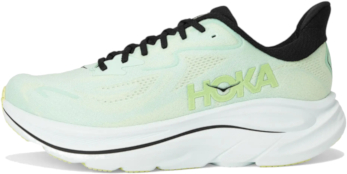
If you’re an older runner dealing with metatarsalgia—that annoying pain in the ball of your foot—you know how tough it can be to find a shoe that actually makes running (or even walking) feel good again. That’s where the Hoka Clifton 10 comes in.
This shoe is packed with soft, responsive cushioning that really helps take the pressure off the forefoot. The thick EVA midsole gives you a nice, pillowy feel underfoot without making the shoe feel bulky or heavy. It’s especially helpful if your feet tend to feel beat up after just a few minutes on the move.
The Clifton 10 also has Hoka’s signature Meta-Rocker design, which basically means it helps roll your foot forward smoothly with every step. That’s great news if you’re trying to avoid putting too much stress on the front of your foot—it makes the whole stride feel more natural and less jarring. The forefoot construction is also stiffer, which helps prevent overloading the forefoot at toe-off.
Another plus? The fit. The toe box has been slightly widened from previous versions, so your toes have more space to spread out. That extra room can make a big difference when you’re trying to ease pressure in the forefoot. And if you need even more space, the Clifton 10 comes in wide and extra-wide options too.
It’s also surprisingly lightweight for how much cushion it offers, which is great if you’re not looking to lug around something heavy on your feet. It weighs 8.8 oz for women and 9.8 oz for men. And with its APMA Seal of Acceptance, you know it’s been given the thumbs-up by foot health experts.
Shop On ZapposHoka Bondi 9
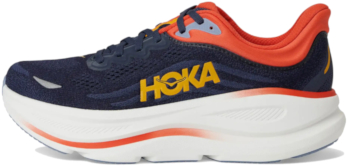
If metatarsalgia has been turning your runs—or even casual strolls—into a pain fest, the Hoka Bondi 9 could be exactly what your feet have been waiting for. This shoe is one of Hoka’s most cushioned models, and that extra padding goes a long way in relieving pressure on the ball of your foot.
The midsole is stacked thick with soft, shock-absorbing foam that creates a super plush landing every time your foot hits the ground. That means less pounding on the forefoot, which is exactly what you want when you’re dealing with metatarsal pain. It’s kind of like walking on marshmallows—if marshmallows were engineered for long-distance comfort and support.
What also makes the Bondi 9 stand out is its rocker-shaped sole. It gently rolls you forward with each step, helping to spread out pressure and reduce the load on the front of your foot. That smooth heel-to-toe transition isn’t just comfortable—it’s a game-changer for anyone trying to avoid forefoot stress.
Plus, the Bondi 9 has a roomy fit, especially in the forefoot area. That gives your toes space to relax instead of being crammed together, which helps prevent that burning, pinching sensation that metatarsalgia loves to bring along. And just like the Clifton 10, this model comes in wide and extra-wide options if you need more breathing room.
Despite all that cushion, the Bondi 9 doesn’t feel clunky. It weighs 9.3 oz for women and 10.5 oz for men. It’s supportive, stable, and built for comfort over long miles—whether you’re still running or just walking for fitness. And it’s got the APMA Seal of Acceptance, so foot experts agree it’s a smart choice for keeping your feet happy.
Shop On ZapposASICS Gel-Cumulus 27
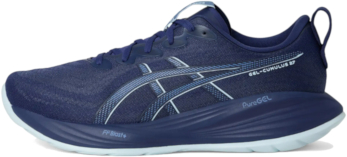
If you’re a runner dealing with metatarsalgia, the ASICS Gel-Cumulus 27 might just be your new go-to shoe. It’s not flashy or over-the-top—it’s just a reliable, well-cushioned everyday trainer that quietly does its job really, really well.
Let’s start with the cushioning, because that’s the big deal here. The Cumulus 27 uses ASICS’ FF BLAST PLUS foam in the midsole, which gives you a soft and responsive ride without feeling mushy. That softness helps reduce impact on the forefoot, giving your metatarsals some much-needed relief, especially on longer runs or walks. It also has rearfoot GEL technology to absorb shock during landing, which adds to the overall comfort and protects your joints as you move.
Another bonus? The Cumulus 27 features a redesigned rocker-like geometry that helps your foot roll more smoothly from heel to toe. That smoother transition means less time and pressure spent on the ball of your foot—exactly what you want if you’re trying to keep forefoot pain in check.
It’s also got a slightly more generous fit in the forefoot than some older models, so your toes have room to spread out instead of being crammed together. That’s key when dealing with metatarsalgia since extra room can reduce irritation and pressure.
And even though it’s cushioned, it doesn’t feel bulky (weighs 8.1 oz for women and 9.3 oz for men). The shoe is light, breathable, and flexible—great for everyday training or even just long walks around the neighborhood. It’s the kind of shoe you can count on whether you’re logging miles or just trying to stay active without aggravating your feet.
Shop On ZapposASICS Gel-Nimbus 27

If metatarsalgia has been making your runs (or even your daily walks) feel more like a foot-punishing event than a stress reliever, the ASICS Gel-Nimbus 27 could be your new BFF. This shoe is all about soft landings, smooth transitions, and keeping your forefoot from screaming after a mile or two.
The big win here is the super plush cushioning. The Nimbus 27 is loaded with FF BLAST PLUS ECO foam, which offers a soft, bouncy ride that doesn’t feel heavy or sluggish. Add in ASICS’ signature rearfoot and forefoot GEL technology, and you’ve got a shoe that seriously reduces impact—especially in the ball of the foot where metatarsalgia pain likes to hang out.
One of the standout features of the Nimbus 27 is how smooth and easy it feels on the move. The updated geometry helps guide your foot through the stride, so you’re not slamming down on your forefoot with every step. That rolling motion helps distribute pressure more evenly and takes a load off those sore metatarsals.
Comfort-wise, it’s got a stretchy, breathable knit upper that adapts to your foot without squeezing it—great news if you deal with swelling or need some extra room in the toe box. Plus, the Nimbus 27 comes in multiple widths, so if you need more space across the forefoot, you’ve got options.
And while it’s a max-cushioned shoe, it doesn’t feel like a brick (weighs 9.3 oz for women and 10.8 oz for men). It’s surprisingly lightweight for how much support it packs in, making it a great option whether you’re still running regularly or just want something that’ll keep you comfortable on long walks or easy jogs.
Shop On ZapposNew Balance Fresh Foam X 880v15
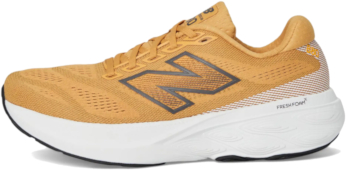
If you’re dealing with metatarsalgia and just want a shoe that feels comfortable, supportive, and easy to wear day in and day out, the New Balance Fresh Foam X 880v15 is definitely worth a look. It’s not flashy or overly complicated—it’s just a solid, dependable trainer that treats your feet with kindness.
The real highlight here is the Fresh Foam X midsole, which gives you a smooth, cushioned ride with just the right amount of softness underfoot. It’s plush enough to take pressure off the ball of your foot—key for easing metatarsalgia pain—but still responsive enough that you won’t feel like you’re sinking into a pillow. It’s that “just right” kind of cushioning that older runners (and sore feet) will appreciate. This midsole foam feels like Nike’s ReactX foam.
What makes the 880v15 especially metatarsalgia-friendly is its balanced and stable design. The dual-layer midsole structure helps absorb shock and reduce impact across the forefoot while offering enough support to keep you feeling secure and steady. Whether you’re going for a light jog, walking the dog, or running errands, the 880v15 helps your feet stay comfortable and protected.
And let’s not forget about the fit. The upper is soft, breathable, and roomy enough in the toe box to let your toes spread out—a must when you’re dealing with forefoot sensitivity. It also comes in multiple widths, so if you need a bit more space, you’ve got options without compromising support.
Shop On ZapposNew Balance Fresh Foam X More v5
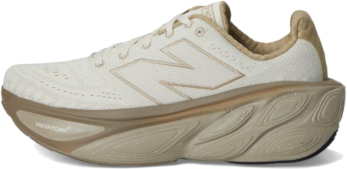
If your feet feel like they’ve had enough of hard landings and forefoot pain, the New Balance Fresh Foam X More v5 is basically a giant, cushioned “you deserve better” hug for your soles. It’s one of the most max-cushioned shoes in New Balance’s lineup—and that makes it a dream pick for older runners dealing with metatarsalgia.
Let’s start with the obvious: this shoe has a ton of foam. We’re talking full-length Fresh Foam X, which is ultra-soft, super shock-absorbing, and perfect for reducing pressure on the ball of your foot. The generous midsole acts like a thick memory foam mattress for your feet, absorbing impact and helping to ease the irritation that comes with metatarsalgia.
What really sets the More v5 apart is its rockered geometry. That means it helps roll your foot forward smoothly from heel to toe, taking some of the load off the forefoot and spreading it out across your entire stride. For older runners with sensitive feet, that can make a huge difference in overall comfort.
The fit is also on point—plenty of room in the toe box, especially helpful if your forefoot tends to swell or if you just need a little breathing space for your toes. And yep, wide widths are available too, because New Balance gets that not all feet are built the same.
Despite all that cushion, the shoe doesn’t feel heavy or clunky. It weighs 8.6 oz for women and 11 oz for men. It’s got a surprisingly stable base, so you get that “walking on clouds” sensation without feeling wobbly. Whether you’re still doing regular runs or just need something super comfortable for long walks, this shoe holds up.
Shop On ZapposNew Balance Fresh Foam X 1080v14
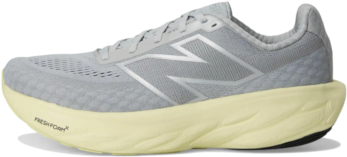
If you’re an older runner dealing with that nagging ball-of-foot pain known as metatarsalgia, the New Balance Fresh Foam X 1080v14 might be just what the doctor—or your feet—ordered. This shoe combines soft cushioning, a smooth ride, and a roomy fit to help keep you moving comfortably without wincing every few steps.
First off, the Fresh Foam X midsole in the 1080v14 is the real MVP. It’s soft and responsive, giving you plenty of impact protection while still feeling light and energetic. That extra cushion under the forefoot helps absorb shock and reduce pressure right where metatarsalgia tends to flare up most.
But it’s not just about the foam. The 1080v14 has a rockered sole that helps guide your foot through a natural heel-to-toe roll. That smooth transition means less time and weight on your forefoot—so there’s less pressure aggravating those already-irritated metatarsals.
Fit-wise, the 1080v14 is super accommodating. The upper is stretchy and breathable, adapting to your foot without squeezing or creating hot spots. There’s plenty of room up front for your toes to spread out, which helps reduce crowding and forefoot pain. And yes, it comes in multiple widths, so if you need a little extra space, you’re covered.
Despite being a max-cushioned shoe, it doesn’t feel bulky (weighs 8.3 oz for women and 10.5 oz for men). It’s lightweight, well-balanced, and versatile enough for daily runs, long walks, or just staying active in comfort.
Shop On ZapposNew Balance Fresh Foam X 860V14
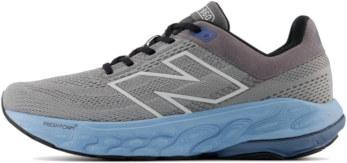
If you’re a runner dealing with metatarsalgia and also need a little extra stability, the New Balance Fresh Foam X 860v14 could be the perfect balance of support and softness your feet have been begging for. It’s the kind of shoe that says, “Don’t worry—I’ve got you,” every time you lace it up.
What makes it shine? Let’s start with the Fresh Foam X midsole—it’s plush without being squishy, offering plenty of cushion under the ball of your foot to help ease that burning, nagging metatarsalgia pain. It soaks up impact, so you’re not pounding your forefoot with every step. And since the pain often flares up the longer you’re on your feet, the 860v14 is built to go the distance comfortably.
But here’s the twist: the 860v14 is also a stability shoe, thanks to its medial post and thoughtful structure that gently guides your stride without feeling stiff. You’ll barely notice it’s there until you reach 5k, where your feet start to long for that needed support. So if you tend to overpronate—or just want a little extra support—you get the comfort and the control. That stability helps reduce excess foot movement, which can keep things more balanced and reduce extra pressure on the forefoot.
It also has a roomy toe box and comes in wide widths, so your toes have space to spread out, breathe, and chill—no squishing allowed. The upper is breathable and flexible, keeping your foot secure without squeezing the life out of it.
Shop On ZapposBrooks Glycerin Max

If your forefoot has been feeling like it’s constantly under fire thanks to metatarsalgia, the Brooks Glycerin Max might just be the soft landing you’ve been looking for. This shoe is all about maximum cushioning (with a massive 47 mm stack height)—and when it comes to easing ball-of-foot pain, more cushion is definitely a good thing.
Let’s start with the obvious: the nitrogen-infused DNA Tuned foam in the midsole. It’s soft, bouncy, and super protective (it’s the future of supercritical foams)—like memory foam that fights back just enough to keep you moving comfortably. That means less impact on the forefoot with every step, which can seriously help reduce the sharp, burning pain that metatarsalgia tends to bring along for the ride.
The rocker-like design of the Glycerin Max also helps you roll through each stride more smoothly. That’s a big win if you’re trying to avoid putting too much pressure on the front of your foot. Instead of jamming your weight into the ball of your foot, this shoe helps distribute it more evenly from heel to toe.
Fit-wise, it’s roomy, especially up front where you need that toe-wiggling space. The engineered mesh upper is breathable and flexible, so your foot gets a secure fit without feeling locked down or restricted. And yes, it comes in wide widths too, which is always a bonus when you’re dealing with foot pain or swelling.
Despite all that cushioning, the Glycerin Max is surprisingly light and easy to move in, weighing 9.5 oz for women and 10.5 oz for men. It doesn’t feel like you’re dragging around bricks—it feels like you’re floating and nimble. Whether you’re running, walking, or just trying to stay active without aggravating your feet, this shoe is built to make every step easier.
Shop On ZapposAdditional Tips for Managing Metatarsalgia
Foot Exercises and Stretching
- Toe Stretch: Sit comfortably with your feet flat on the floor—this isn’t a foot boot camp (yet). Now lift your toes off the ground like they’re trying to wave hello, but keep your heels glued down like they’ve got trust issues. Hold for 5 seconds, then let those toes chill. Repeat 10 times or until your feet start feeling smug about doing toe yoga.
- Towel Stretch: Sit on the floor with your legs stretched out like you’re about to fail at yoga. Loop a towel around the ball of one foot and gently pull it toward you—no yanking, this isn’t a rodeo. Hold for 15–30 seconds, then switch feet and repeat 2–3 times per side. It’s like giving your foot a polite invitation to stretch without starting a rebellion.
- Foot Roll: Grab a golf ball or a frozen water bottle—your foot’s new best friends. Roll it under your foot for 5–10 minutes to melt away tension and boost circulation. It’s like a mini foot massage without the awkward spa small talk. Bonus: The frozen bottle doubles as revenge against inflammation.
- Calf Stretch: Stand facing a wall like you’re about to apologize to it, place your hands on it for support, and step one foot back like you’re striking a dramatic pose. Keep the back leg straight, heel glued to the ground (no tiptoeing!), and feel that glorious calf stretch. Hold for 15–30 seconds, then switch legs and repeat 2–3 times—because both calves deserve equal love, even if one’s clearly the overachiever.
- Arch Lift: Stand with your feet flat like you’re preparing for a very polite showdown. Now try to lift just your arches—no cheating with the toes or heels. It’s like giving your foot muscles a secret handshake. Hold for 5 seconds, then relax and pretend you didn’t just make a weird face. Repeat 10–15 times, or until your arches start acting like proud little overachievers.
- Heel Raises: Stand with your feet shoulder-width apart like you’re about to make a bold announcement. Slowly rise onto your toes like you’re trying to peek over a fence—or impress someone with your calf muscles—hold for a dramatic second, then lower back down like the graceful human you are. Repeat 10–15 times, or until your calves start asking why they weren’t consulted about leg day.
- Foot Flex and Point: Sit back, stretch those legs out like you’re preparing for a very chill yoga session. Flex your foot back toward you like you’re telling it, “come here,” then point your toes away like you’ve changed your mind. Repeat 10–15 times per foot—yes, both deserve equal attention. Add these toe-wiggling moves to your daily routine to help calm down metatarsalgia flare-ups and remind your feet who’s boss (spoiler: it’s still gravity, but you’re trying).
Orthotics and Inserts
Orthotics and inserts are like tiny foot therapists—minus the awkward small talk. They support your arches, spread out pressure, and take the heat off your aching forefoot like a team of well-trained pain ninjas. By gently coaxing your feet into a more natural position, they help reduce the stress on those overworked metatarsal bones (who’ve frankly had enough).
Custom orthotics go the extra mile by cushioning the ball of your foot, absorbing shock, and helping you stay stable—so you don’t walk like you’re dodging invisible Legos. With regular use, they ease discomfort, improve foot mechanics, and help you go about your day with less limping and more living. Your feet may even stop plotting revenge.
When to Consult a Specialist
If your foot pain is sticking around like an unwanted houseguest—even after all your self-care heroics—it’s time to call in the pros. See a specialist if the pain won’t quit, your foot starts looking lumpy or swollen, your walk turns into a wobble, or you start feeling weird tingling like your toes are texting each other.
And if the pain is messing with your day-to-day life (like making you dread walking to the fridge), don’t tough it out—get checked out. A specialist can give you a proper diagnosis, a customized treatment plan, and maybe even save you from a lifelong grudge match with your feet.
Best Shoes for Metatarsalgia FAQs
What are the best shoes for metatarsalgia?
The best shoes for metatarsalgia are like therapy for your feet—plenty of cushioning, solid arch support, and a roomy toe box so your toes aren’t crammed in like commuters on a Monday morning train. Podiatrists often give the thumbs-up to brands like Brooks, New Balance, and Vionic—because they’re built to take the heat off the ball of your foot, not make it feel like it’s walking on hot coals. Comfort first, fashion second (but luckily, some of these shoes manage both without looking like you borrowed them from your great-uncle Stan).
How can shoes help relieve metatarsalgia pain?
Shoes made for metatarsalgia are like personal assistants for your feet—they absorb shock, take the pressure off your metatarsal bones, and keep everything aligned so your toes don’t start a rebellion. The right pair spreads your body weight more evenly, turning painful strolls into actual walks instead of dramatic limps. Basically, they do all the work, so you can stop tiptoeing through life like the floor is lava.
What features should I look for in metatarsalgia footwear?
When shopping for shoes that won’t make your forefoot cry, look for the dream team: cushy cushioning, solid arch support, a roomy toe box (because your toes are not sardines), and a flexible sole that moves with you—not against you. Bonus points for a rocker bottom design—it helps roll you forward like you’re gliding through life, not limping through it. Your feet will thank you, possibly with fewer complaints and a lot less sass.
Final Thoughts on the Best Shoes for Metatarsalgia
Metatarsalgia can be a major roadblock for older runners, but the right footwear can help you stay active without the pain. The top 9 shoes we’ve highlighted are specifically chosen for their forefoot cushioning, support, and overall comfort—key features that reduce pressure on the ball of the foot and ease every stride. Whether you’re jogging around the neighborhood or training for your next 5K, investing in the right pair can mean the difference between discomfort and a rewarding run. Don’t let foot pain hold you back—step into relief and keep moving forward.
You may also like:
